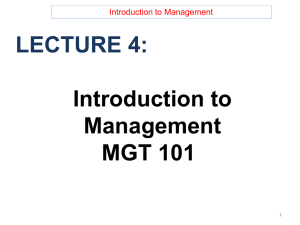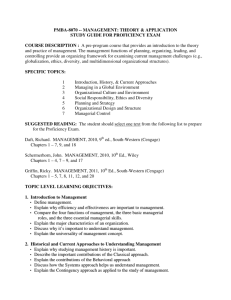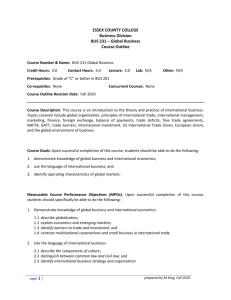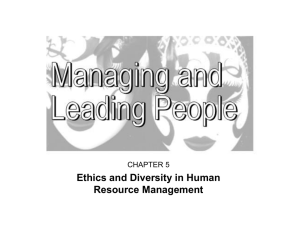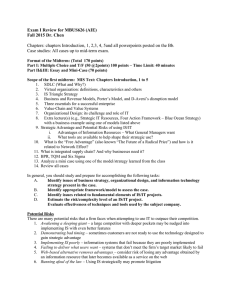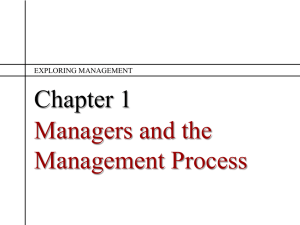bus.201.outline.f2010 - Student Learning Outcomes (SLO)
advertisement
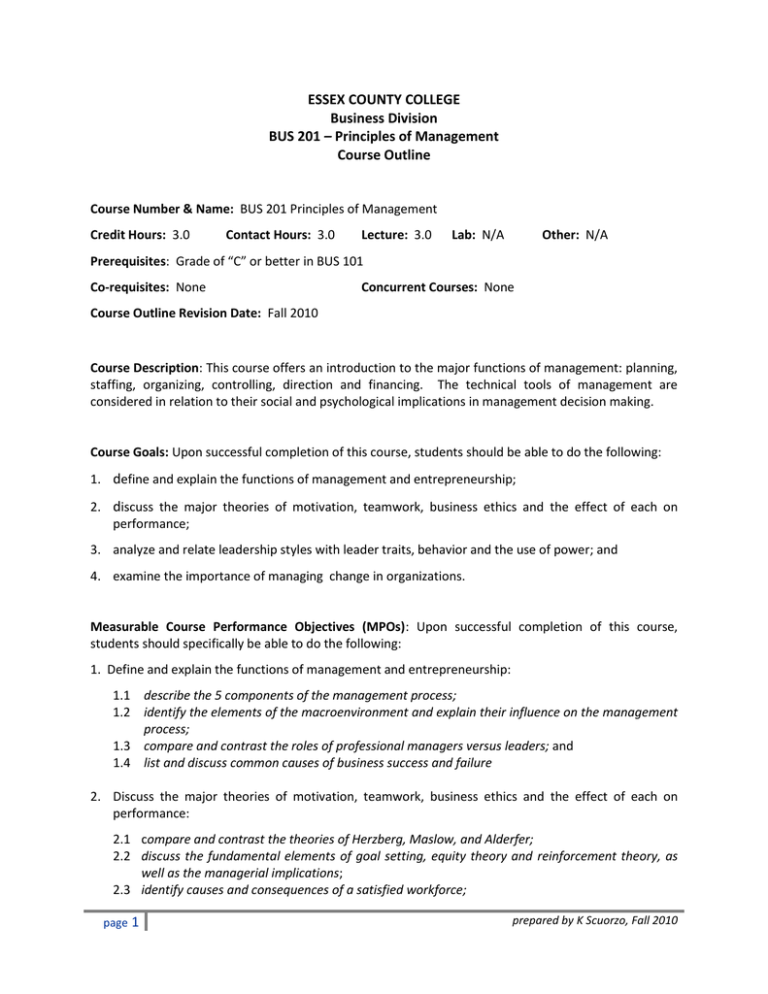
ESSEX COUNTY COLLEGE Business Division BUS 201 – Principles of Management Course Outline Course Number & Name: BUS 201 Principles of Management Credit Hours: 3.0 Contact Hours: 3.0 Lecture: 3.0 Lab: N/A Other: N/A Prerequisites: Grade of “C” or better in BUS 101 Co-requisites: None Concurrent Courses: None Course Outline Revision Date: Fall 2010 Course Description: This course offers an introduction to the major functions of management: planning, staffing, organizing, controlling, direction and financing. The technical tools of management are considered in relation to their social and psychological implications in management decision making. Course Goals: Upon successful completion of this course, students should be able to do the following: 1. define and explain the functions of management and entrepreneurship; 2. discuss the major theories of motivation, teamwork, business ethics and the effect of each on performance; 3. analyze and relate leadership styles with leader traits, behavior and the use of power; and 4. examine the importance of managing change in organizations. Measurable Course Performance Objectives (MPOs): Upon successful completion of this course, students should specifically be able to do the following: 1. Define and explain the functions of management and entrepreneurship: 1.1 describe the 5 components of the management process; 1.2 identify the elements of the macroenvironment and explain their influence on the management process; 1.3 compare and contrast the roles of professional managers versus leaders; and 1.4 list and discuss common causes of business success and failure 2. Discuss the major theories of motivation, teamwork, business ethics and the effect of each on performance: 2.1 compare and contrast the theories of Herzberg, Maslow, and Alderfer; 2.2 discuss the fundamental elements of goal setting, equity theory and reinforcement theory, as well as the managerial implications; 2.3 identify causes and consequences of a satisfied workforce; page 1 prepared by K Scuorzo, Fall 2010 Measurable Course Performance Objectives (MPOs) (continued): 2.4 explain how people’s individual needs affect their behavior; and 2.5 explain how companies influence their ethics environment 3. Analyze and relate leadership styles with leader traits, behavior and the use of power: 3.1 explain how a good vision helps one be an effective leader; 3.2 identify sources of power in organizations; and 3.3 describe behaviors that will make one a better leader 4. Examine the importance of managing change in organizations: 4.1 discuss ways to manage technology for a competitive advantage; 4.2 describe diversity in today’s workforce; 4.3 explain how changes in today’s workforce make diversity a critical organizational and managerial issue; and 4.4 list and discuss tactics for managing resistance to change Methods of Instruction: Instruction will consist of lecture, CONNECT assignments, class discussions, group work, and guest lecturers. Outcomes Assessment: CONNECT, quiz, and exam questions are blueprinted to course objectives. Data is collected and analyzed to determine the level of student performance on these assessment instruments in regards to meeting course objectives. The results of this data analysis are used to guide necessary pedagogical and /or curricular revisions. Course Requirements: All students are required to: 1. Maintain regular attendance. 2. Complete all assignments in a timely manner 3. Take part in class discussion and work with fellow students on in-class exercises. 4. Take all quizzes and exams, when scheduled. page 2 prepared by K Scuorzo, Fall 2010 Methods of Evaluation: Final course grades will be computed as follows: Grading Components % of final course grade Attendance, Punctuality and Participation Students must attend and participate in class to benefit from the expertise of the instructor. NOTE: After 2 absences and/or late arrivals 1 point will be deducted from the grade. 5 – 10% 5 CONNECT Assignments CONNECT is a web-based assignment instrument required for this course. CONNECT is designed to assist students with coursework based on their specific needs. 15 – 20% 2 CONNECT or In-class Quizzes Quizzes will show evidence of the extent to which students meet course objectives, including but not limited to identifying and explaining course concepts Midterm Exam The midterm exam will show evidence of the extent to which students meet course objectives that were covered during the first half of the semester. 20 – 25% Final Exam The final exam will show evidence of the extent to which students meet course objectives that were covered during the last half of the semester. 25 – 30% 20 – 30% NOTE: The instructor will provide specific weights, which lie in the above-given ranges, for each of the grading components at the beginning of the semester Academic Integrity: Dishonesty disrupts the search for truth that is inherent in the learning process and so devalues the purpose and the mission of the College. Academic dishonesty includes, but is not limited to, the following: plagiarism – the failure to acknowledge another writer’s words or ideas or to give proper credit to sources of information; cheating – knowingly obtaining or giving unauthorized information on any test/exam or any other academic assignment; interference – any interruption of the academic process that prevents others from the proper engagement in learning or teaching; and fraud – any act or instance of willful deceit or trickery. Violations of academic integrity will be dealt with by imposing appropriate sanctions. Sanctions for acts of academic dishonesty could include the resubmission of an assignment, failure of the test/exam, failure in the course, probation, suspension from the College, and even expulsion from the College. page 3 prepared by K Scuorzo, Fall 2010 Student Code of Conduct: All students are expected to conduct themselves as responsible and considerate adults who respect the rights of others. Disruptive behavior will not be tolerated. All students are also expected to attend and be on time for all class meetings. No cell phones or similar electronic devices are permitted in class. Please refer to the Essex County College student handbook, Lifeline, for more specific information about the College’s Code of Conduct and attendance requirements. page 4 prepared by K Scuorzo, Fall 2010 Course Content Outline: based on the text Management, 9th edition, by Bateman, Thomas S & Snell, Scott A; published by McGraw-Hill/Irwin, 2011; ISBN #: 978-0-07-813724-2 Class Meeting (80 minutes) Chapter/Content 1 Review Class Syllabus 2–3 4–5 6–7 CHAPTER 1 MANAGING 1.1 Managing for the Competitive Advantage 1.2 The Functions of Management 1.3 Management Levels and Skills CHAPTER 2 THE EXTERNAL ENVIRONMENT AND ORGANIZATIONAL CULTURE 2.1 The Macroenvironment 2.2 The Competitive Environment 2.3 Environmental Analysis 2.4 The Internal Environment of Organizations CONNECT Assignment 1 due CHAPTER 3 MANAGERIAL DECISION MAKING 3.1 The Stages of Decision Making 3.2 Barriers to Effective Decision Making 3.3 Group Decision Making 3.4 Organizational Decision Making 8 Quiz 1 on Chapters 1, 2 & 3 CHAPTER 4 PLANNING AND STRATEGIC MANAGEMENT 4.1 Planning Fundamentals 9 4.2 4.3 10 – 11 12 – 13 14 page 5 Levels of Planning Strategic Planning CHAPTER 5 ETHICS AND CORPORATE RESPONSIBILITY 5.1 Business Ethics and the Decision Making Process 5.2 Corporate Social Responsibility CONNECT Assignment 2 due CHAPTER 6 INTERNATIONAL MANAGEMENT 6.1 The Global Environment and Strategies 6.2 Modes for Entering an Overseas Market 6.3 Managing Across Borders Midterm Exam on Chapters 1 – 6 prepared by K Scuorzo, Fall 2010 Class Meeting (80 minutes) 15 16 17 18 19 Chapter/Content CHAPTER 7 ENTREPRENEURSHIP 7.1 Becoming an Entrepreneur 7.2 Corporate Entrepreneurship CHAPTER 8 ORGANIZATIONAL STRUCTURE 8.1 Fundamentals of Organizing 8.2 The Vertical and Horizontal Structures CHAPTER 9 ORGANIZATIONAL AGILITY 9.1 Effect of Strategy, Size and Technology on Organizational Agility 9.2 Customers and the Responsive Organization CONNECT Assignment 3 due CHAPTER 10 HUMAN RESOURCE MANAGEMENT 10.1 Human Resource Management Process 10.2 Performance Appraisal and Reward Systems 10.3 Labor-Management Relations CHAPTER 11 MANAGING THE DIVERSE WORKFORCE 11.1 Components of a Diversified Workforce 11.2 Challenges and Advantages of Diversity 11.3 Organizational Methods for Cultivating a Diverse Workforce 20 Quiz 2 on Chapters 7, 8, 9, 10 & 11 CHAPTER 12 LEADERSHIP 12.1 Traditional Approaches to Understanding Leadership 21 12.1 12.2 22 23 24 – 25 page 6 Traditional Approaches to Understanding Leadership (continued) Contemporary Perspectives on Leadership CHAPTER 13 MOTIVATING FOR PERFORMANCE 13.1 Survey of Motivational Theories 13.2 Designing Motivating Jobs CONNECT Assignment 4 due CHAPTER 14 TEAMWORK 14.1 Types of Teams 14.2 Transforming Groups into Teams 14.3 Building Effective Teams CHAPTER 15 COMMUNICATING 15.1 Interpersonal Communication 15.2 Improving Communication Skills 15.3 Organizational Communication prepared by K Scuorzo, Fall 2010 Class Meeting (80 minutes) 26 27 – 28 Chapter/Content CHAPTER 16 MANAGERIAL CONTROL 16.1 Bureaucratic Control Systems 16.2 Market Controls CONNECT Assignment 5 due CHAPTER 17 MANAGING TECHNOLOGY AND INNOVATION 17.1 Assessing Technology Needs 17.2 Key Factors in Technology Decisions 17.3 Acquiring New Technology 29 CHAPTER 18 CREATING AND MANAGING CHANGE 18.1 Managing Resistance and Enlisting Cooperation 18.2 Shaping the Future 30 Final Exam on Chapters 7 – 18 page 7 prepared by K Scuorzo, Fall 2010
